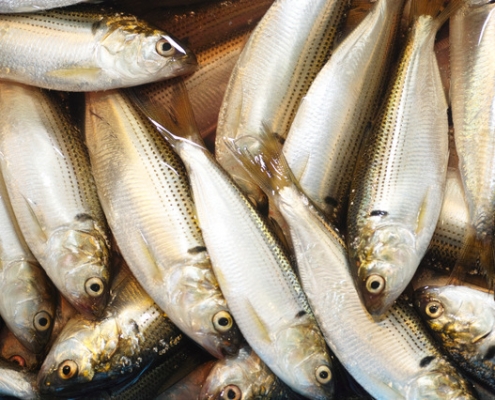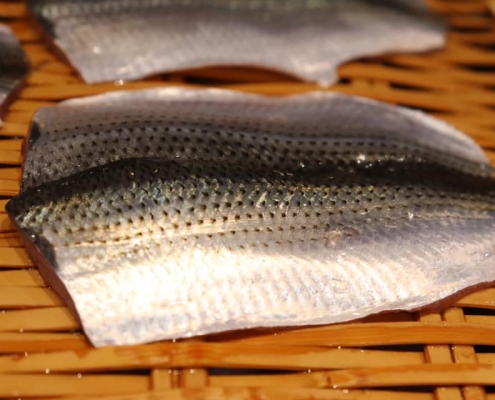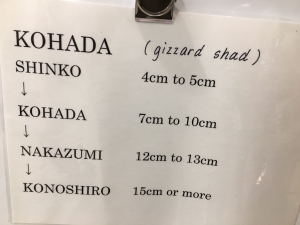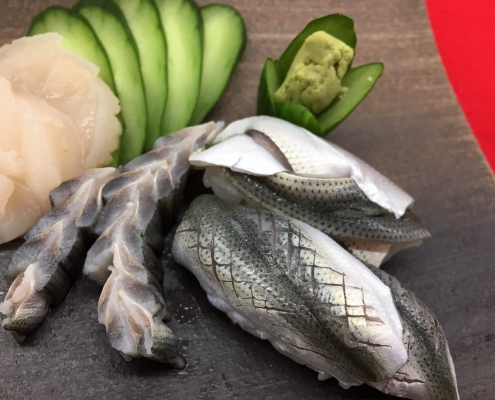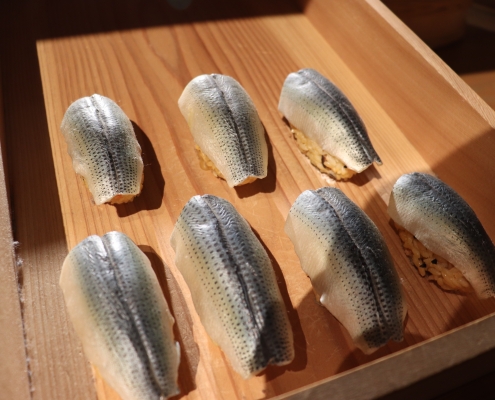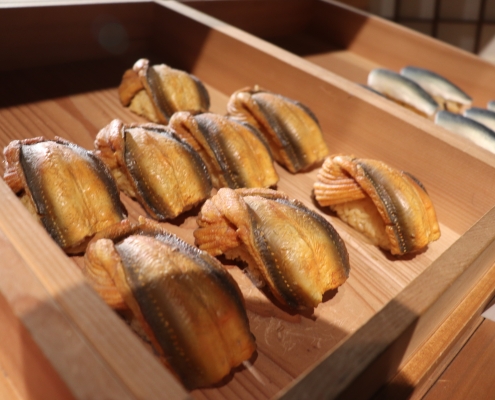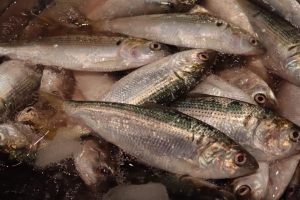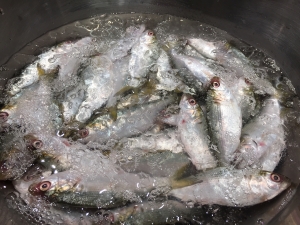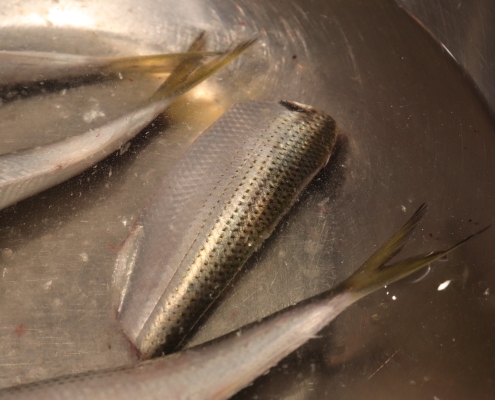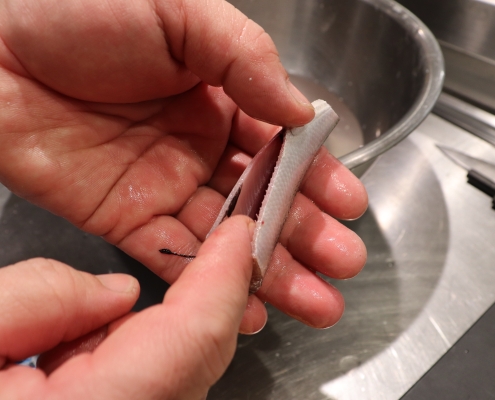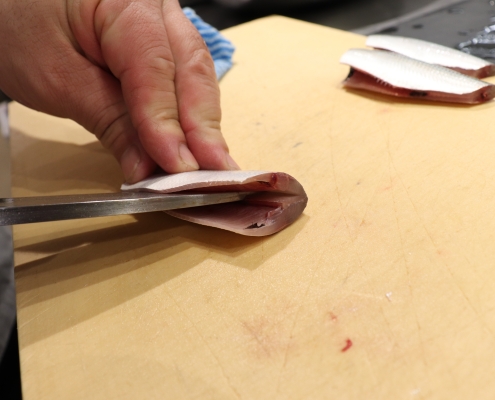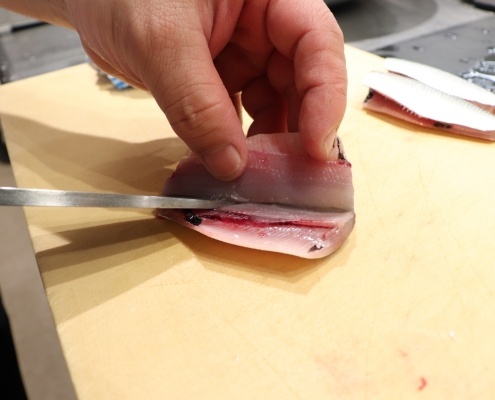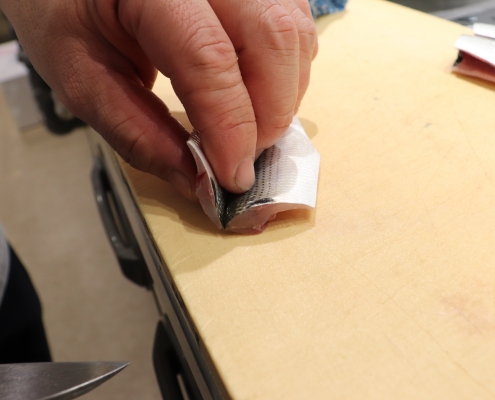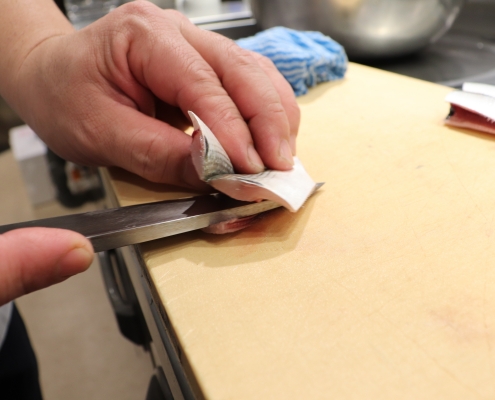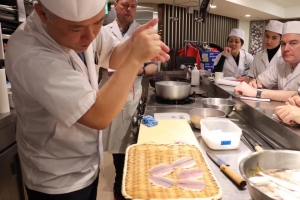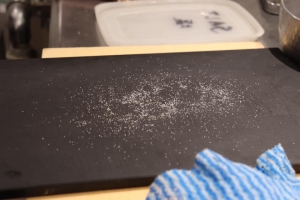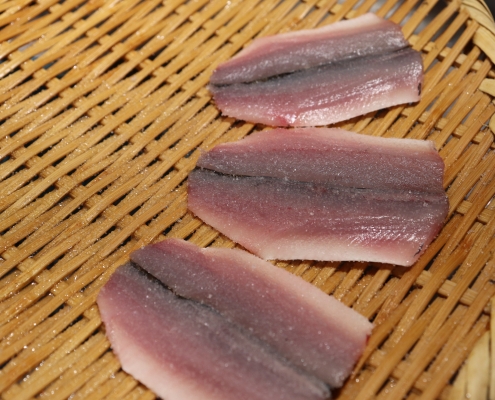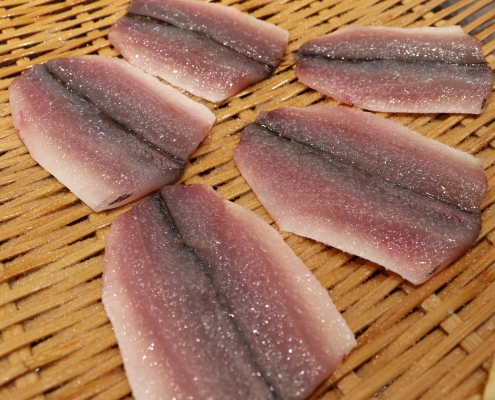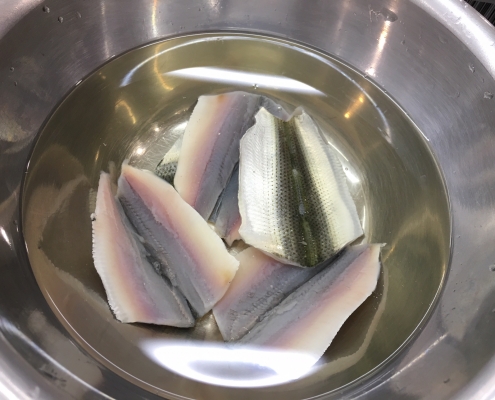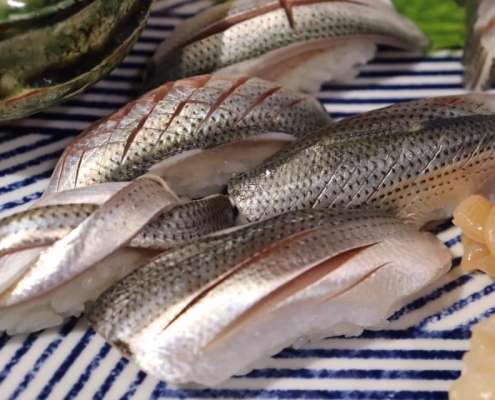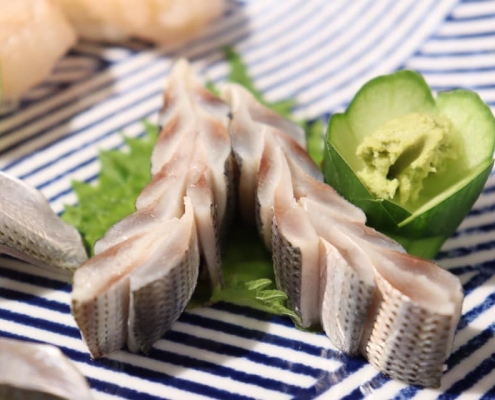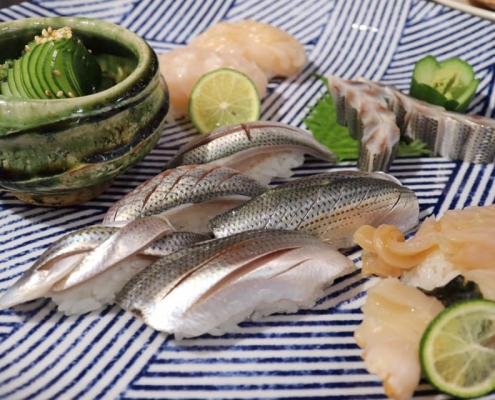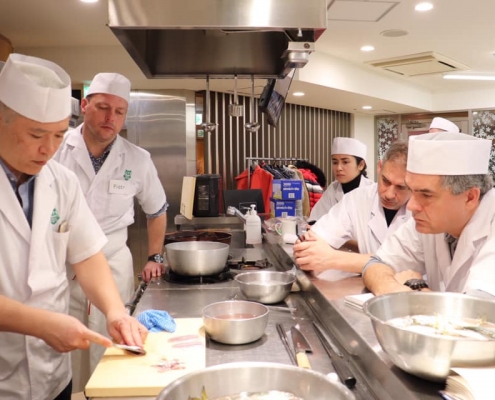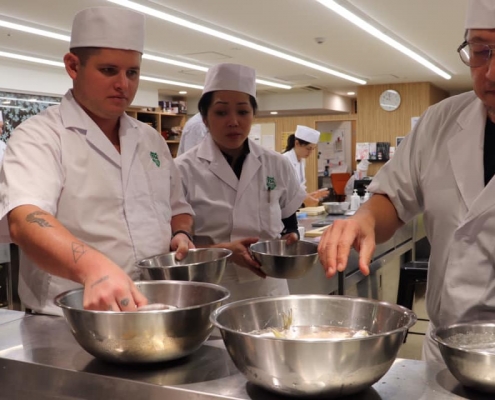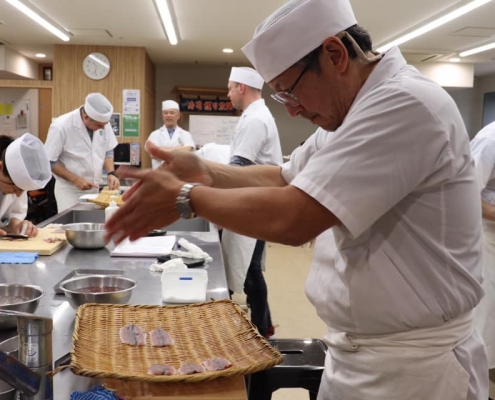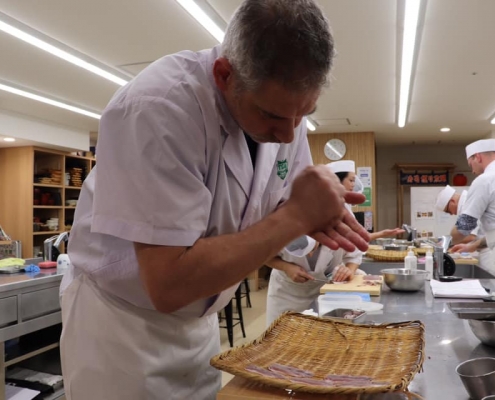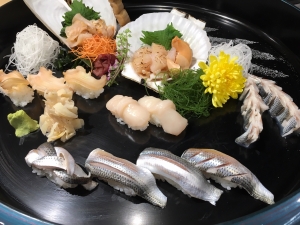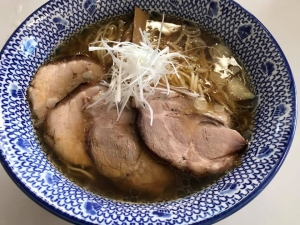Kohada Gizzard Shad: How to Salt and Marinate in Vinegar for Sushi?
March 11th 2020 updated
This beautiful silver-skinned fish is one of the most common toppings for Edomae style sushi, representative of “hikari-mono” (topping of fish with shinny skin). Usually kohada is marinated in vinegar. The fish is cheap and rarely used expect for sushi, but its umami fully emerges by being salted and marinated in vinegar.
In Sushi Chef: Sukiyabashi Jiro, a bible book for sushi chefs, kohada is described as “Yokozuna of Nigiri” (Yokozuna is the highest rank of sumo wrestlers). It is one of the masterpieces along with tuna and anago (Conger eel) in modern Edomae sushi.
Kohada’s name changes in accordance with its size. “Shinko” indicates the fish of about 4-5 centimeters in length, available around June. When it is called “kohada,” the fish reaches 7-10 centimeters. It depends on individual taste, but the best season comes around November through January, when the fish gets fattier.
How to judge the quality?
Good-quality kohada has dense scales and a thick body. In winter, the fist starts to contain more fat.
Why do Japanese gourmets like kohada?
Kohada is known for its soft meat and a lot of small bones as well as its characteristic scent. It does not taste good as it is, and we usually do not eat the fish raw. However, once experienced sushi chefs treat it properly with salt and vinegar, adjusting their amount to the fish’s size and fat content, kohada transforms into an exquisite sushi piece that impresses gourmets in Japan.
Kohada and anago have been evolving along with the chefs’ techniques throughout the history of Edo-style sushi. Even today, many critics judge the chef’s craftsmanship with the quality of kohada and anago.
How much is kohada?
Kohada sells for 1,000 to 2,000JPY per kilogram on average, according to the wholesale prices at the Tokyo Metropolitan Central Wholesale Market in the last few years. If we estimate that one fish used for sushi weighs 40 grams, each costs 25 to 50JPY. Make two pieces out of one fish and we will have one piece for 12.5 to 25JPY. It takes time to prepare the fish, but the sushi tastes good for such a low price.
Since old days, gourmets have been very particular about the best time of eating kohada. The price for shinko in early summer can even exceed 50,000JPY(About 450USD) per kilogram. If one fish weighs 10 grams, each costs 500JPY. As shinko is smaller than kohada, you need two fishes for one sushi piece, which ends up costing 1,000JPY. Nevertheless, customers who are well-versed with Edomae sushi are waiting for shinko and cannot help paying for it despite the expense.
Let’s see the process of making kohada sushi in the class of Tokyo Sushi Academy.
How to fillet kohada?
There are two tips for filleting kohada.
First, since kohada is heat sensitive, you need to minimize touching so that its temperature may not rise.
Secondly, you need to know how long to salt and marinate fish in vinegar. The following are the steps of filleting kohada.
1. Soak fish in ice water
2. Cut off the dorsal fin
3. Remove the scales
Remove all the scales at this point. After you marinate it in vinegar, it is more difficult to detach them.
4. Cut off the head
Cut in next to the black spot.
5. Cut off the tail
6. Cut off the belly
7. Pull out the innards
8. Dip in ice water
Dip in ice water and remove the remaining innards with fingers.
9. Cut off the remaining belly part
10. Insert the knife
Insert the knife so that its tip touches the back of the dorsal fin. Keep slicing to the bottom of the belly bone.
11. Butterfly the fish
Butterfly the fish while feeling the tip of the knife with your left hand.
12. Flip the fish
Flip the fish so that the skin side faces up and the exposed back bone rests on the cutting board. Cut through above the back bone.
13. Slice off the belly bone
14. On the other side as well.
How to salt the fish?
It is important to know how to salt kohada. Its flavor greatly varies depending on how much and how long you apply salt.
Sprinkle salt on wet bonzaru (bamboo strainer). Place kohada on its skin side and sprinkle salt.
See this picture to get a sense of how much salt you need to sprinkle over the fish.
We decided to wait for 20 minutes on this day, though the length varies depending on the size or fat content of the fish and temperature. The picture shows the fish right after we sprinkled salt and 10 minutes after. You can see how much moisture is removed from the fish.
After 10min
You can see how much moisture is removed from the fish.
How to marinate in vinegar?
After washing off the salt with fresh water, you marinate the fish in vinegar. The amount of time to marinate can be estimated as the 60% of the time you salt the fish.
Since we salted the fish for 20 minutes this time, we marinated it in vinegar for 12 minutes.
Then, we place the fish on bonzaru and let the vinegar sink in.
Here are three reasons for marinating the fish in vinegar:
1. Prevent umami from escaping
The main nutrition of fish and meat is protein, which can be solidified by vinegar. As I mentioned above, kohada has soft meat, but vinegar solidifies protein and keeps the fish from losing its shape.
In addition, vinegar helps to keep umami elements inside the fish, which would otherwise dissolve in water.
2. Erase fishy smell
Compared to beef, pork, or chicken, fish tends to have a stronger “fishy” smell. This is because trimethylamine oxide, an odor-less component, is dissolved by bacteria after fish dies and becomes trimethylamine that gives off the smell.
Since trimethylamine is alkaline, you can neutralize it and erase the smell by adding acidic ingredients, such as vinegar.
3. Soften Small Bones
As vinegar is an acidic ingredient, it softens the small bones in kohada and makes it easier to eat.
Kohada Nigiri Sushi
With silver-skinned kohada, let’s enhance its appearance by using elaborate cutting techniques. These techniques can also improve the texture, and thus maximize your dish’s quality both in its taste and presentation.
Since the class at Tokyo Sushi Academy also used White Geoduck and scallops on this day, the students made nigiri sushi with the three toppings.
How was the class of salting and marinating kohada? It is necessary for you to figure out how much and how long to salt and marinate the fish by trying time and again with your own taste. These techniques can be also applied to other kinds of fish.
Do join 4-weeks Sushi Course at Tokyo Sushi Academy and learn Edo-style techniques in its hometown, Tokyo!
Related Articles
What would you like to know more?

Tokyo Sushi Academy
The first and the most popular sushi school in the world.
Japan Culinary Institute
Japanese culinary training including sushi, kaiseki, yakitori, wagashi and more.
Miyajima Ramen School
More than 1,000 graduates from over 50 countries.
International Ramen School
Ramen study program combined with OJT

